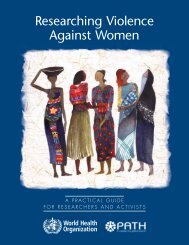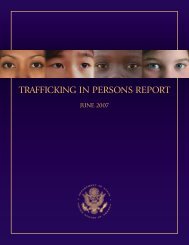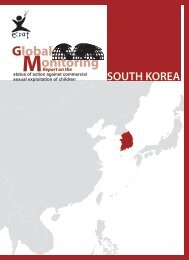Download PDF - Violence Against Children - East Asia and the ...
Download PDF - Violence Against Children - East Asia and the ...
Download PDF - Violence Against Children - East Asia and the ...
Create successful ePaper yourself
Turn your PDF publications into a flip-book with our unique Google optimized e-Paper software.
Sri Lanka<br />
• economic problems<br />
• access to <strong>and</strong> quality of education<br />
• a safe home environment<br />
• <strong>the</strong> effects of armed conflict<br />
• health<br />
A strong push by Save <strong>the</strong> <strong>Children</strong> to<br />
support children to advocate for <strong>the</strong>mselves<br />
was successful. It led to provincial meetings<br />
of children <strong>and</strong> a children’s parliament where<br />
a children’s agenda was formed <strong>and</strong><br />
presented to <strong>the</strong> Government. Notably, Save<br />
<strong>the</strong> <strong>Children</strong> reviewed its own programs in<br />
light of <strong>the</strong> children’s agenda, <strong>and</strong> plans to<br />
improve <strong>the</strong> monitoring of CRC criteria at<br />
community level, as <strong>the</strong> national approach is<br />
inevitably "distant". The problem of child<br />
abuse, for example, has been noted in <strong>the</strong><br />
1998 presidential taskforce reports but no<br />
clear idea is expressed as to how this links to<br />
monitoring in <strong>the</strong> community. <strong>Children</strong>’s<br />
organisations have identified local issues <strong>and</strong><br />
advocated with local authorities.<br />
Save <strong>the</strong> <strong>Children</strong> has observed that some<br />
issues are sensitive in local communities<br />
when it impacts on profit or politics. For this<br />
reason, children need to be equipped<br />
through training in ways to protect<br />
<strong>the</strong>mselves when advocating on an issue.<br />
Entry points to communities<br />
Increased child participation, <strong>and</strong> specific<br />
education approaches, are two ways to reduce<br />
<strong>the</strong> risks children face. There are o<strong>the</strong>rs.<br />
World Vision’s work with community<br />
leaders on issues such as livelihood <strong>and</strong> credit<br />
also ensures community recognition <strong>and</strong><br />
support for children to develop more of a<br />
voice through <strong>the</strong> <strong>Children</strong>’s Societies (see<br />
following section). Development experience<br />
in Sri Lanka shows that a twin process of<br />
developing community <strong>and</strong> children gives a<br />
stronger structure for <strong>Children</strong>’s Societies to<br />
act toge<strong>the</strong>r across an area. Since microcredit<br />
addresses a key issue of poverty, it<br />
links well with child protection measures.<br />
The challenge of linkage is a critical one, as<br />
advocacy opportunities exist if data is shared<br />
<strong>and</strong> appropriate<br />
indicators set.<br />
World Vision’s study on child abuse <strong>and</strong><br />
neglect 4 noted <strong>the</strong> importance of public<br />
awareness <strong>and</strong> coalition-building that grows<br />
from <strong>the</strong> needs in <strong>the</strong> community <strong>and</strong> does<br />
not over-sensationalise issues.<br />
The Sri Lankan conflict has constrained<br />
advocacy, in that comment on its negative<br />
impacts on child development as outlined in<br />
<strong>the</strong> CRC could put staff <strong>and</strong> projects at risk.<br />
For example, <strong>the</strong> LTTE communicated that<br />
<strong>the</strong>y didn’t want NGOs to comment on <strong>the</strong>ir<br />
involvement of children in <strong>the</strong> armed conflict.<br />
(At <strong>the</strong> international level, however, <strong>the</strong>re has<br />
been NGO pressure on <strong>the</strong> LTTE not to use<br />
children as soldiers.)<br />
At community level, none<strong>the</strong>less, <strong>the</strong>re<br />
have been useful examples of children<br />
advocating locally on o<strong>the</strong>r issues of<br />
protection, <strong>and</strong> promoting change.<br />
Useful approaches to<br />
building child participation<br />
Examples of children working effectively to<br />
influence families, communities <strong>and</strong><br />
government are clear in Sri Lanka. Promoting<br />
children through developing people’s<br />
organisations, establishing or streng<strong>the</strong>ning<br />
children’s associations, <strong>and</strong> introducing a child<br />
rights curriculum in schools are examples of<br />
child protection in practice. Lessons may be<br />
learned from good practice in this area <strong>and</strong><br />
applied to o<strong>the</strong>r areas, influence government<br />
policy/practice, <strong>and</strong>/or contribute to practice<br />
in o<strong>the</strong>r countries. 5<br />
4 Dorning, K, Crying Out: <strong>Children</strong> <strong>and</strong> communities speak on abuse <strong>and</strong> neglect, World Vision International, 2002 (http://www.wvi.org/imagine/can.htm)<br />
5<br />
Implementation H<strong>and</strong>book for <strong>the</strong> Convention on <strong>the</strong> Rights of <strong>the</strong> Child, UNICEF, 1998<br />
69

















